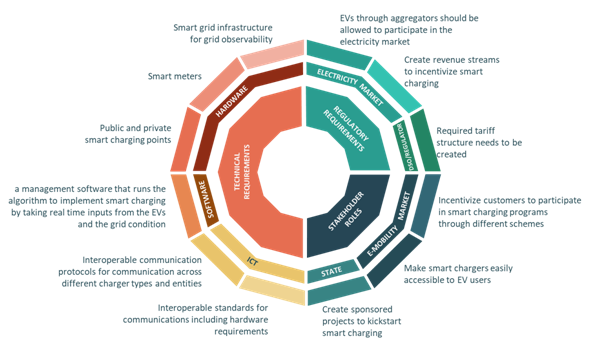Accommodating Charging Load Due to High Electric Vehicle Adoption and Tackling Grid Impacts: Grid Reinforcement vs Smart Charging
Written by Angshu Plavan Nath and Zakir Hussain Rather
Electric vehicles have seen rapid growth as a response to increased concerns over global warming and climate change. By eliminating the tailpipe emissions, the EVs would help in improving the local air quality while also being a tool for energy security [1]. Powering these fleets of EVs can add a significant load to the electricity grid. While the additional energy needed to power the EVs would roughly constitute 2.7% of individual countries’ total energy generation, the impact on the local energy distribution is far more significant [1].
The distribution grids were designed to cater to the traditional loads in the system. With the increasing adoption of EVs in the grid, the power infrastructure may face different challenges such as voltage drops, overloading in grid infrastructure, congestion, phase imbalance, etc [2]. To address the grid impacts of increased EV adoption on the electrical networks, large-scale reinforcement of the electrical grid may be needed. However, the requirements would be highly dependent on the individual grid networks, the local EV growth, and the headroom availability in the network. Grid reinforcement is not only capital-intensive but also time-consuming.
While grid reinforcement may be inevitable, it can be deferred by controlling and coordinating the charging of EVs, thereby reducing the stress in the grid. In smart charging (V1G), the EV charging is controlled by shifting the time of charging and regulating the charging power depending on the operating conditions of the network and the requirements of the EV owner, i.e., an external controller controls the EV charging based on predefined objectives and constraints. Unlocking smart charging requires different components and infrastructure as mentioned below:
- Smart Charging Capable Electric Vehicle Supply Equipment: The EVSE that is being used to charge the vehicle should have smart charging capability with communication capabilities. Smart chargers are generally 20%-70% costlier compared to similarly rated dumb chargers, dependent on the connectivity features such as LAN, WLAN, Bluetooth, etc. [3]
- Smart Meter: The next important piece of equipment to facilitate smart charging is a smart meter, to enable logging of energy consumption with time of use. The smart meter also acts as the communication gateway between the utility and the user. With most utilities already moving towards replacing traditional energy meters with smart energy meters around the world, this would not constitute an additional expense for smart charging.
- Charging Management Software: The charging management software is the central hub that coordinates the charging of the EV. The cost of the management system is vendor specific and depends on the included functionalities.
- Information and Communication infrastructure: The information and communication infrastructure includes the data storage, management, and analysis component and the physical communication infrastructure that needs to be installed such as fiber cables/ telephone lines/ radio wave transmission system, etc. based on the connection technology being used. For an electric utility like a distribution network operator, this would probably be one of the added investments to enable smart charging. However, the same infrastructure could also be used for other smart grid applications.
The different requirements for the implementation of smart charging have been provided in Figure 1.
Figure 1. Requirements for enabling smart charging [4].
Compared to grid reinforcement, where the utility has to invest significant capital on the grid infrastructure, in smart charging the investment made by the utility is significantly reduced. A study at Hamburg’s distribution grid in Germany determined that a 9% increase in the EV stock in the city corresponding to 60,000 EVs would cause bottlenecks in 15% of the distribution network feeders in the city. Grid reinforcement to accommodate the EVs would need an investment of at least 20 million Euros, while the estimated investment for smart charging is only around 2 million Euros. So, the cost of implementation of smart charging to control the EV load is 90% less than the grid reinforcement cost [5]. The Green eMotion project conducted across different cities in the European Union also found that smart charging can reduce the grid reinforcement cost by 50%, while a separate study by the Sacramento Municipal Utility in the United States found that smart charging can reduce grid reinforcement costs by 70% [5].
Another much cheaper alternative to communication-based active smart charging is the use of tariffs for passive control of EV charging. The use of time-based EV tariffs such as time-of-day, time-of-use, and real-time pricing incentivizes the EV user to shift their charging to off-peak periods leading to a potential reduction in the peak load of the network [6]. Using such passive smart charging, the cost of implementation for the utility is further reduced, as they do not need to invest in any additional information and communication infrastructure other than that smart metering infrastructure.
Conclusion
With the increasing penetration of electric vehicles, the electrical grid is expected to experience various technical issues unless adequate countermeasures are in place. While grid reinforcement may be needed, the requirement may be significantly reduced and deferred by controlling the charging profile of EVs through the use of smart charging.
Acknowledgment
This work was supported by the India-EU collaborative project SUSTENANCE funded by the Department of Science and Technology (DST) on the Indian side and the European Commission on the EU side.
References
- IEA, "Grid Integration of Electric Vehicles: A manual for policy makers," International Energy Agency, 2022.
- Z. Rather, R. Banerjee, A. Nath and P. Dahiwale, "Fundamentals of electric vehicle charging technology and its grid integration," Deutsche Gesellschaft für Internationale Zusammenarbeit (GIZ) GmbH, NITI Aayog, New Delhi, 2021.
- L. Lanz, B. Noll, T. S. Schmidt and B. Steffen, "Comparing the levelized cost of electric vehicle charging options in Europe," Nature Communications, vol. 13, no. 5277, 2022.
- Z. Rather, A. Nath, D. Lekshmi and R. Banerjee, "Electric Vehicle Charging Infrastructure and its Grid Integration in India: Status Quo, Critical Analysis and Way Forward," Deutsche Gesellschaft für Internationale Zusammenarbeit (GIZ) GmbH, NITI Aayog, New Delhi, India, 2022.
- IRENA, "Innovation outlook: smart charging for electric vehicles," International Renewable Energy Agency, 2019.
- A. Nath, Z. Rather, I. Mitra and Sahana, "Multi-criteria approach for identification and ranking of key interventions for seamless adoption of electric vehicle charging infrastructure," IEEE Transactions on Vehicular Technology (early access), 2023.
This article was edited by Cesar Duarte.
To view all articles in this issue, please go to June 2023 eNewsletter. For a downloadable copy, please visit the IEEE Smart Cities Resource Center.


To have the Bulletin delivered monthly to your inbox, join the IEEE Smart Grid Community.
Past Issues
To view archived articles, and issues, which deliver rich insight into the forces shaping the future of the smart grid. Older Bulletins (formerly eNewsletter) can be found here. To download full issues, visit the publications section of the IEEE Smart Grid Resource Center.





